| NHK Learning Fair 2001 |
| The "NHK Learning Fair 2001" was held at the NHK Broadcasting
Center in Shibuya, Tokyo from November 16 to 18. The fair's themes
were children's education and future and the role that the public
broadcaster plays in education. It included a variety of public
events, including exhibitions using the latest technology developed
at STRL. By providing a learning experience that incorporated play,
these events demonstrated to many of the children visiting the site
that learning can be fun. |
 |
Puppet show in a virtual
studio: "Adventure! Mekarappa"
|
| This futuristic puppet show
was created in a virtual studio with CG background images.
Children were invited to experience the virtual studio firsthand. |
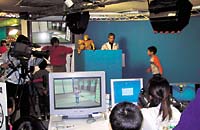 |
 |
 |
|
English conversation: "I
want to hear it spoken slowly!"
|
| Application of a speech rate
conversion technology, which is already being used in language
study programs, makes it possible for a user to listen to
a skit from an English conversation program at a slower than
natural rate, while maintaining the same voice pitch. |
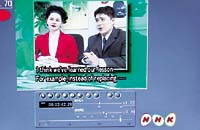 |
 |
 |
|
Braille educational programs
using data broadcasting
"Information barrier-free reception terminals"
|
| These reception terminals convert
data broadcasting information into Braille to assist those
with visual impairments. In the exhibition, the technology
was used to provide Braille information to visually impaired
children. |
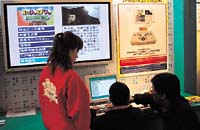 |
 |
 |
|
Let's play
"Zawazawa mori-no Ganko-chan"
|
| By automatically measuring
the location of a subject, the new 3-D Axi-vision camera can
compose CGs without having to use the chroma-keying technique.
At the learning fair, an Axi-vision composed a CG of the popular
dinosaur character "Ganko-chan", which entertained the children. |
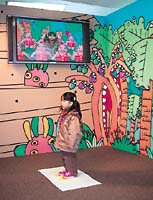 |
 |
 |
|
"Experience the future classroom!"
"NHK's all-digital educational material"
|
| Visitors experienced a future
classroom environment in which students use all-digital educational
materials. For instance, visitors were shown how a video report
could be created by retrieving video material from a digital
video database. |
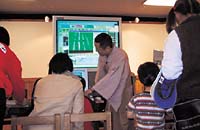 |
 |
 |
|
Chinese conversation: Check
your pronunciation
|
| This exhibition featured a
pronunciation lesson in which the student could compare his
or her own pronunciation against a model in the form of a
graph by using the language training tool "Seicho Nigo." This
tool is currently used in the Educational TV program "Chinese
conversation." |
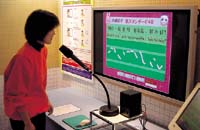 |
 |
 |
|
Closed-captioning broadcast
for children: "News broadcast transcription system"
|
| This system, which has already
been partially implemented in some news programs, automatically
converts the speech portion of a news program into a transcription.
During the fair, a demonstration was made of a closed-captioning
service for children with hearing impairments. |
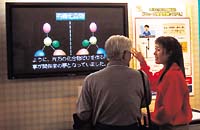 |
 |
 |
|
 |

